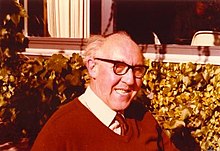Thomas Willmore
Thomas James Willmore (born April 16, 1919 in Gillingham , † February 20, 2005 ) was a British mathematician who dealt with differential geometry .
Life
Willmore studied at King's College London with the degree in 1939. During the Second World War he worked for the Royal Air Force on systems of tethered balloons for air defense (including against V1 rockets that exploded on contact with the lines) and wrote his dissertation at the same time. In 1943 he received his doctorate from the University of London on a topic from general relativity and cosmology ( Clock regraduations and general relativity ). The suggestion to deal with it came after hearing a lecture by Albert Einstein . In 1946 he became a lecturer at the University of Durham . In 1954 he moved to the University of Liverpool , where Arthur Geoffrey Walker was already , with whom he had published a book on harmonious spaces in 1953. One reason for this, according to his widow, was that one of the professors in Durham, who had been wounded in World War I, refused to buy German math books for the university library. In 1965 he went back to the University of Durham as a professor of pure mathematics. In Durham he founded the Durham Symposia of the London Mathematical Society in 1974. He was the director of the mathematics department in Durham several times. In 1984 he retired.
He was the first math professor in Great Britain without a background from the elite universities of Oxford or Cambridge. Although he was admitted to Cambridge, studying there was too expensive for him.
He introduced the concept of Willmore energy , which can be understood as elastic bending energy in the three-dimensional space of embedded surfaces and, for example, has applications on cell membranes - they try to minimize them. It is equal to the integral of the square of the mean curvature over the area. A conjecture about a lower bound of the Willmore energy of a torus (and generally areas of gender greater than or equal to 1) in three-dimensional space is named after him. The conjecture proved fruitful for research into differential geometry. In this context there are also Willmore surfaces named after him, generalizations of minimal surfaces that make the Willmore energy minimal.
In 1994 he received an honorary doctorate from the Open University . From 1977 to 1979 he was Vice President of the London Mathematical Society . He was a member of the Royal Belgian Academy of Sciences.
He was married to the mathematician Gillian Boughton.
Willmore was a personal friend of Edward Collingwood and made sure that his math library came to Durham, identified by books bound in wood from Nelson's flagship Victory - Collingwood was a descendant of Admiral Collingwood.
Fonts
- with HS Ruse, Arthur Geoffrey Walker Harmonic spaces , 1953
- An introduction to differential geometry , Oxford University Press 1959
- with Nigel Hitchin Global Differential Geometry , Ellis Horwood 1984
- Riemannian Geometry , Oxford University Press 1997
Web links
Individual evidence
- ^ Obituary at the University of Durham 2005, see web links
| personal data | |
|---|---|
| SURNAME | Willmore, Thomas |
| ALTERNATIVE NAMES | Willmore, Thomas James |
| BRIEF DESCRIPTION | British mathematician |
| DATE OF BIRTH | April 16, 1919 |
| PLACE OF BIRTH | Gillingham |
| DATE OF DEATH | February 20, 2005 |
